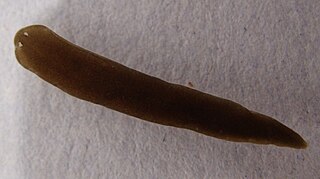
Planaria is a genus of planarians in the family Planariidae. Due to its excellent ability to regenerate, species of Planaria has also been used as model organisms in regeneration studies. When an individual is cut into pieces, each piece has the ability to regenerate into a fully formed individual. When decapitated, they retain their memories.

Dugesia is a genus of dugesiid triclads that contains some common representatives of the class Turbellaria. These common flatworms are found in freshwater habitats of Africa, Eurasia, and Australia. Dugesia is best known to non-specialists because of its regeneration capacities.

Planariidae is a family of freshwater planarians.

Dugesiidae is a family of freshwater planarians distributed worldwide. The type genus is Dugesia Girard, 1850.

Schmidtea is a genus of freshwater triclads. Species of the genus Schmidtea are widely used in regeneration and developmental studies.

Maricola is a suborder of triclad flatworms including species that mainly inhabit salt water environments. However, some species are also known from freshwater or brackish waters.
Dugesia golanica is a species of dugesiid triclad that inhabits freshwater bodies of Israel. The species is named after the Golan Heights.

Dugesia aenigma is a species of dugesiid triclad that inhabits freshwater bodies of Cephalonia, Greece.

Kenkiidae is a family of freshwater triclads. Their species can be found sporadically in caves, groundwater, and deep lakes in Central Asia, Far East and North America.
Girardia tigrina, known as the brown planarian or the immigrant triclad flatworm, is a species of dugesiid native to the Americas. It has been accidentally introduced into Europe and Japan.

Schmidtea polychroa is a species of freshwater flatworm, a dugesiid triclad that inhabits the shallow mesotrophic or eutrophic waters of rivers and lakes of Europe. It is also present in North America, where it has been introduced at least in the Saint Lawrence river system. It is an animal with a limited dispersion capability.

Dugesia sagitta is a species of dugesiid triclad that inhabits the rivers of Corfu, Greece. The specimens of this species are up to 10 millimetres (0.39 in) long and 3 millimetres (0.12 in) wide.
Cura is a genus of freshwater flatworm (triclads) belonging to the family Dugesiidae.
Spathula is a genus of dugesiid triclad. Its species are found in Australia and New Zealand.
Centrovarioplana tenuis is a species of Maricola triclad that is found in Antarctica. It is the only species known in the monotypic genus Centrovarioplana and the family Centrovarioplananidae.

Dimarcusidae is a family of triclads found mostly in freshwater habitats of caves, although at least one species, Rhodax evelinae, occurs in surface waters. Currently the family contains only seven species distributed in five genera, although the total number of species is thought to be much higher.
Neppia is a genus of dugesiid triclad that is found in South America, Subantarctic region, Africa, Tasmania and New Zealand.
Reynoldsonia reynoldsonia is a freshwater dugesiidae triclad found in Australia. It is the only species in the genus Reynoldsonia. It was named in honor of Professor Trefor B. Reynoldson.
Cura pinguis is a species of dugesiid triclad found in Australia and New Zealand.

Roman Kenk was a Slovenian, later American, zoologist.











